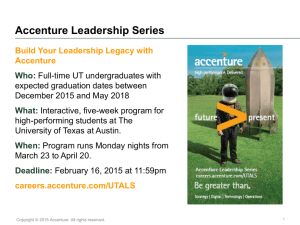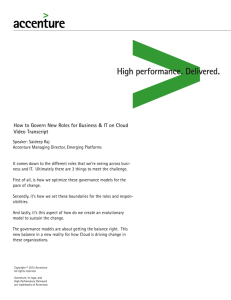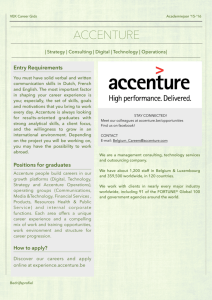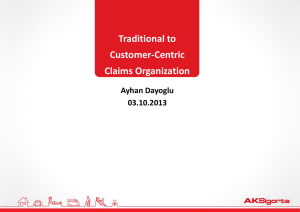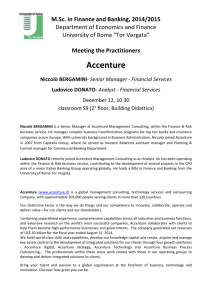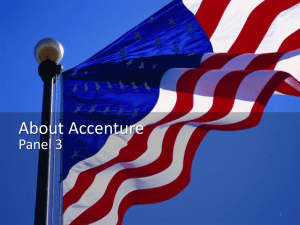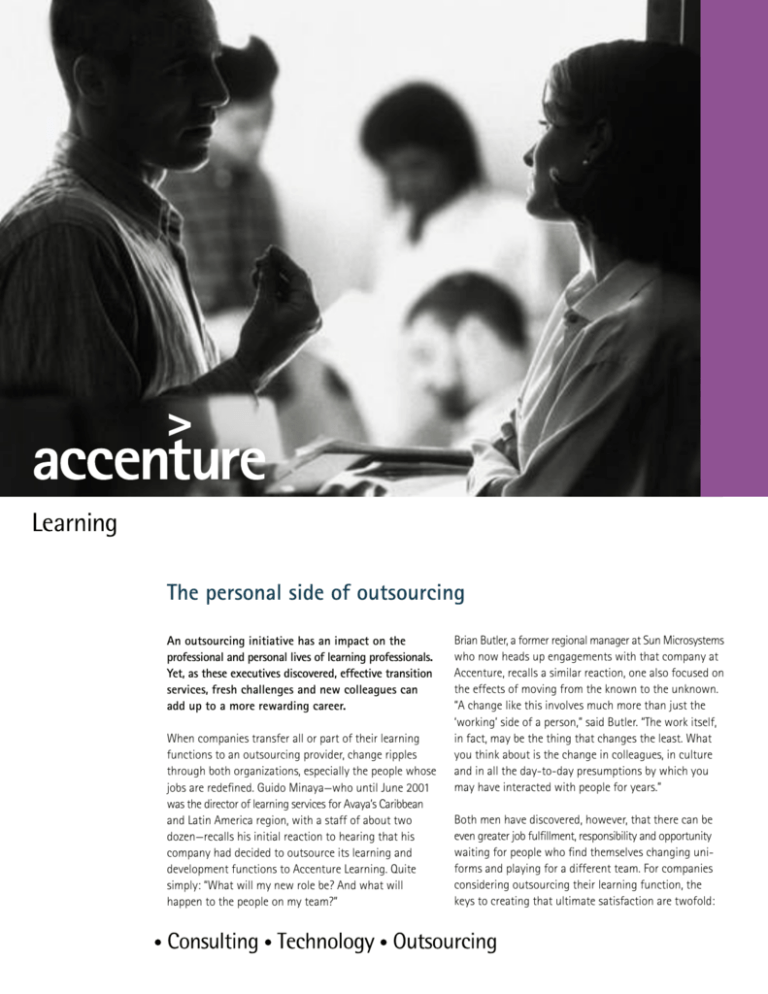
The personal side of outsourcing
An outsourcing initiative has an impact on the
professional and personal lives of learning professionals.
Yet, as these executives discovered, effective transition
services, fresh challenges and new colleagues can
add up to a more rewarding career.
When companies transfer all or part of their learning
functions to an outsourcing provider, change ripples
through both organizations, especially the people whose
jobs are redefined. Guido Minaya—who until June 2001
was the director of learning services for Avaya’s Caribbean
and Latin America region, with a staff of about two
dozen—recalls his initial reaction to hearing that his
company had decided to outsource its learning and
development functions to Accenture Learning. Quite
simply: “What will my new role be? And what will
happen to the people on my team?”
Brian Butler, a former regional manager at Sun Microsystems
who now heads up engagements with that company at
Accenture, recalls a similar reaction, one also focused on
the effects of moving from the known to the unknown.
“A change like this involves much more than just the
‘working’ side of a person,” said Butler. “The work itself,
in fact, may be the thing that changes the least. What
you think about is the change in colleagues, in culture
and in all the day-to-day presumptions by which you
may have interacted with people for years.”
Both men have discovered, however, that there can be
even greater job fulfillment, responsibility and opportunity
waiting for people who find themselves changing uniforms and playing for a different team. For companies
considering outsourcing their learning function, the
keys to creating that ultimate satisfaction are twofold:
providing transition services and support
that can address head-on the challenges of
“leaping into the unknown,” and ensuring
that the work at the end of the transition
is something that gives the employees a
renewed vigor and engagement with new
roles and responsibilities.
Greener grass?
One important
insight shared by
Minaya was the fact
that life before outsourcing is rarely an
idyllic world that is
then shattered by the
new arrangement.
Minaya’s role prior
Guido Minaya
to outsourcing was focused on developing
training delivery strategies that were aligned
with Avaya’s Caribbean and Latin America
region leadership. Although the innovative
solutions from Minaya’s team made the role
exciting, it was also very challenging. “It was
difficult to get product course materials on
time prior to the launch of a new product,”
Minaya said. “In fact, the international
regions were usually the last to receive
content that was applicable to new product
launches. This made the training readiness
objective difficult to meet. We never had
done an adequate job of developing learning
prior to the introduction of a new product
launch,” he said.
Minaya and his global
team also faced a history of unclear investment levels and team
size. “It was difficult
to manage training
without clarity regarding investments in
Brian Butler
our internal training
infrastructure.” In fact, Minaya ultimately
interpreted his company’s outsourcing
decision as a commitment to learning, not
a de-emphasis. “When I first heard of the
outsourcing decision, I felt some comfort
knowing that Avaya was making a strategic
decision to improve the effectiveness of
learning, rather than just cut the budget or
downsize the staff.”
Making the transition
Change management and transition activities are vital to the success of an outsourcing
arrangement. They help ensure that services
continue without interruption, and also
address the apprehension and fear of
the unknown for affected employees. For
example, Accenture Learning has a complete
methodology called “Transition Services”
that not only moves learning services effectively from the client to Accenture Learning,
but also addresses the transition issues
from a personal point of view. This process
brings people up to date on what their
new roles will involve and demonstrates
a commitment to them and attention to
their concerns.
Communications play
a big role in ensuring
that transition services produces a new
learning department
that is fully operational more quickly.
“A couple of things
Norbert Krebs
were especially
effective for us,” said Peggy Dougherty,
a delivery manager who transitioned to
Accenture Learning from AT&T Wireless (now
Cingular). “We received an e-newsletter from
the transition team every Monday morning,
which would talk about the progress of the
outsourcing effort and some resources that
would be available to us. It was also the
vehicle for asking and answering questions
on people’s minds. I thought the transition
team performed extremely well in communicating what was going on, why it was
going on and what the progress was. That
team worked on the plans and processes
that needed to be in place to transition our
wireless training operation in its entirety to
Accenture Learning.”
Norbert Krebs, a former Avaya operations
manager who moved to a director position
at Accenture Learning in January 2002,
noted that keeping all parties informed
also means providing clear and consistent
messages. “What was helpful in the transition was the strong commitment expressed
by leadership—especially clear communica-
tions about how we could work together to
achieve the ultimate goal of uninterrupted
services to customers through the transition
period,” he said.
At Avaya, Accenture
Learning held weekly
conference calls
with the affected
team members. “My
first few weeks with
Accenture were
quite impressive,”
Peggy Dougherty
said Minaya. “It was
a challenging scenario to leave my former
company, but the weekly calls and access
to information I needed made it easier to
understand my options.”
As questions occurred to Minaya, both personal (“What are the new career progression
options available to me?”) and professional
(“What tools and learning architectures
does my new employer use?”), he got
immediate answers from John Hubbell,
executive director of transition services at
Accenture Learning.
“There is a two-pronged effort in doing a
transition,” Hubbell said. “One is around
the people, and one is around the service.
People transition is all about getting people
successfully moving to their new organization. Service transition is about moving the
service from the existing client’s processes
to the new processes.” In both cases, time
is of the essence. The first 90 days, said
Hubbell, are critical for both the employee
and the client services.
Minaya’s immediate supervisor made sure
that he and other delivery team members
understood what it is like to be part of
Accenture Learning, and they led the way
to the transformation needed in the global
delivery operations. Minaya met with the
Accenture Learning team face-to-face, and
then, through regular conference calls and
e-mail newsletters, he was kept up to date on
the progress of the transition to Accenture
Learning. Minaya played a role in helping
his team transition, as well. “I was able to
represent our team as we began working on
improved role definitions,” he said. “It was
exciting to see my team members take on
expanded roles within Accenture Learning.”
What’s on the other side?
A transition period is truly effective only if
meaningful and fulfilling work is waiting on
the other side. Many employees discover that
their careers are enhanced with the company
they’ve moved to. “The opportunity side of
the equation is perhaps the most welcome,
and sometimes unexpected, benefit of moving
from one company to another during an
outsourcing arrangement,” said Nelson Frye,
executive director of account management
at Accenture Learning. Frye, who has managed several learning outsourcing transitions,
added, “Transitioned employees can often
look forward to building new skills and
participating in new client opportunities. For
example, those involved with delivery often
expand their knowledge base into curriculum
design and development. Others may get the
opportunity to teach or work abroad.”
“I have gotten more opportunities presented
to me at Accenture Learning,” agreed Butler.
“Sun offered me a rewarding career as well,
but due to the nature of the economy and
its business, the learning department was in
a downsizing mode. At Accenture Learning,
we’re in a big growth pattern, and there is
constant opportunity that I am being offered
here. I feel it’s a very challenging position, but
one that’s welcomed. I am happy with the
growth opportunities here, and I wouldn’t
trade that for anything, really.”
Krebs emphasized two aspects of the opportunities that result from an outsourcing
arrangement: personal career development
and richer interactions with new colleagues.
“I have been given excellent career development opportunities from the beginning,”
Krebs said. “But perhaps more important, I
have had the opportunities to develop richer
work experiences with expanded responsibilities,
first in a different geography and then on a
global level. A second kind of opportunity,
however, comes through the interaction with
new people on a global basis. I found I was
now with a larger community of learning
professionals that shared my passion for the
corporate learning field.”
Dougherty echoed this sense of the expanded
opportunities made available by transferring over to the outsourcing provider. “You
find yourself now as part of a large team
focused on multiple clients,” she said. “You
have more resources available to you. There
are more people with different backgrounds
and different client experiences. I have found
that my peers or colleagues are both willing
and able to share their experiences and share
resources or different solutions.”
Transitioned employees in a learning outsourcing arrangement generally continue to
feel a deep sense of commitment and loyalty
to their former employer (because that is the
client they are now serving), and that feeling
is to everyone’s advantage. In the case of Avaya,
following the outsourcing arrangement,
Accenture Learning and the former Avaya
employees immediately set out to improve
the quality of the learning programs that
accompanied the release of new products, as
well as the ability to measure the effectiveness
of learning. “In the first few months, we all
worked very hard to understand what the
existing work processes were, how these
might be changed, and how Avaya University could improve its overall efficiency and
effectiveness,” Minaya said. “I think around
month five of the outsourcing, I was getting
a much better view of the types of learning programs needed in other regions. That
was an improvement, as well. Before, I had
absolute visibility into the Caribbean and
Latin America region but not as much into
the other regions.”
This greater organizational connectivity gave
Minaya a new perspective across learning
geographies, which he could share with his
colleagues. “I started seeing a gap in the
Asia-Pacific and Japan regions—they were
not well-connected to the U.S. operations,”
he said. “So I recommended to Accenture
Learning leadership that I could potentially
support the region and leverage some of my
team’s successes from the Caribbean and
Latin America region. A week later, I was on a
plane to Singapore.”
Minaya said that it was a rewarding experience to work with his new team in Asia and
Japan. “I was able to leverage my knowledge
and expertise from my previous role and
assist Avaya in Asia to improve its learning
operations. My wife and two children loved
the time we spent in Singapore,” he said.
Learning BPO success stories like those of
Minaya, Dougherty, Krebs and Butler are not
uncommon, especially when a professional
or a team is sent to an organization with a
knowledge base and resources that support
that particular field. The new arrangement
is a “win-win-win.” Employees are happy to
have job continuity and to be able to work in
a field that interests them. The organization
that receives them is pleased to add enthusiastic and qualified personnel to its workforce. And customers often benefit because
they now have a dedicated team with a true
customer service perspective.
Using an innovative approach, Accenture
Learning works with organizations to establish
a clear and ongoing link between learning
investments and business results. With
deep industry knowledge, patented learning
processes and technologies, and proven delivery capabilities Accenture Learning is uniquely
positioned to help organizations convert their
learning investments into high performance.
“I feel that I’m on a roll now—fully utilizing
the capabilities I have, and being respected
for what I can bring to the table,” Butler said.
“It’s a challenging new position, but one that
has brought with it many rewards.”
Accenture is a global management consulting, technology services and outsourcing
company. Committed to delivering innovation, Accenture collaborates with its clients
to help them become high-performance
businesses and governments. With deep
industry and business process expertise,
broad global resources and a proven track
record, Accenture can mobilize the right
people, skills and technologies to help clients
improve their performance. With more than
110,000 people in 48 countries, the company
generated net revenues of US$13.67 billion
for the fiscal year ended Aug. 31, 2004. Its
home page is www.accenture.com.
This article originally appeared in a Chief
Learning Officer magazine special report
published in April 2005 (www.clomedia.com).
About Accenture Learning
Accenture Learning collaborates with its clients
to help them significantly improve business
and operational performance by unleashing
the value of their workforces, channel partners
and customers. Delivering training to more than
1 million learners globally each year, Accenture
Learning is one of the largest learning services
providers in the world. Providing a full range
of global learning services—from content
development to comprehensive outsourcing
of the learning function—Accenture Learning
designs each solution to meet the specific
needs of a client organization.
To learn more about the unique
capabilities of Accenture Learning,
visit www.accenture.com/learning.
About Accenture
Copyright © 2005 Accenture.
All rights reserved.
Accenture, its logo, and
High Performance Delivered
are trademarks of Accenture.

